Overview
The article highlights the essential PMB ICD-10 codes that every healthcare provider should be familiar with to ensure accurate billing and reimbursement.
Have you ever felt overwhelmed by the complexities of coding? You're not alone. Mastering these codes is not just a technical requirement; it’s a crucial step toward reducing claim denials and enhancing the financial health of your medical practice.
Imagine how precise coding can lead to improved reimbursement rates and operational efficiencies. This not only benefits your practice but ultimately enhances the care you provide to your patients. By alleviating some of the administrative burdens, you can focus more on what truly matters—your patients' well-being.
As you navigate this challenging landscape, remember that understanding these codes can make a significant difference. We encourage you to engage with resources and training that can empower you in this area. Together, we can create a more efficient and compassionate healthcare environment.
Introduction
In the complex world of healthcare, navigating the intricacies of PMB ICD-10 codes can often feel overwhelming for providers. It’s understandable to feel daunted by these essential codes, as mastering them is not just about compliance; it’s about unlocking the potential for enhanced patient care and streamlined billing processes.
Consider this staggering statistic: nearly 35% of claim denials stem from coding errors. This highlights the urgency to understand and implement these codes effectively. How can healthcare professionals leverage this knowledge to improve their practices? It’s not only about meeting regulatory standards; it’s about enhancing the overall quality of care for patients.
Imagine the relief that comes from reducing claim denials and improving patient outcomes. By focusing on these codes, providers can alleviate some of the administrative burdens that often distract from direct patient care. The journey to mastering PMB ICD-10 codes is not just a task; it’s a vital step towards delivering the best possible care.
Let’s explore how we can navigate this landscape together. What resources or strategies can support you in this endeavor? Your commitment to understanding these codes can lead to significant improvements in your practice and the lives of your patients.
CosmaNeura: Optimize PMB ICD-10 Billing with AI-Powered Solutions
In today's healthcare landscape, providers face significant emotional challenges. The increasing expenses of medical services can weigh heavily on both patients and providers, creating a pressing need for solutions. CosmaNeura understands these struggles and utilizes sophisticated AI technology to optimize invoicing procedures for pmb icd 10 codes.
By automating administrative tasks such as patient intake and coding suggestions, medical providers can significantly reduce errors and save valuable time. Imagine being able to focus more on patient care rather than getting bogged down by paperwork. This optimization not only improves invoicing precision but also enhances communication and coordination among care teams.
Such efficiencies align with the mission of providing compassionate medical services while adhering to Catholic teachings. Ultimately, this approach transforms service delivery in a financially sustainable manner.
Consider the impact of these advancements on your practice. How much more could you achieve if administrative burdens were lifted? With CosmaNeura, you can embrace a future where compassionate care is at the forefront, allowing you to serve your patients better.

Understanding PMB ICD-10 Codes: A Key to Effective Medical Billing
PMB ICD-10 classifications play a pivotal role in effective medical billing by providing a standardized framework for documenting diagnoses and procedures. For many healthcare providers, mastering these codes can feel overwhelming, yet it is essential for submitting claims that accurately reflect the services rendered. This accuracy is crucial for securing appropriate reimbursement and alleviating financial stress. Did you know that precise programming can reduce claim denial rates from 20% to under 5%? This significant improvement can enhance cash flow dramatically.
As of 2025, the healthcare environment has experienced a staggering 35% of claim denials related to classification mistakes, costing U.S. healthcare approximately $25 billion annually. This highlights the urgent need for accurate documentation. The implementation of ICD-10 has broadened the classification system from 14,000 to over 70,000 diagnosis codes, improving specificity by 50% since its adoption in 2015. This increased granularity not only aids in justifying medical necessity but also helps identify trends in patient care and outcomes, ultimately elevating the quality of care provided.
For instance, consider a primary care appointment for knee discomfort classified with ICD-10 M25.561, which can obtain a reimbursement of $150. This example demonstrates the direct financial impact of precise classification. Accurate ICD-10 classification directly influences the financial health of healthcare practices by reducing denial rates and accelerating cash flow. It is essential for providers to navigate the complexities of medical billing effectively.
Healthcare providers who have adopted ICD-10 classification have reported enhanced reimbursement rates and operational efficiencies. By utilizing these systems effectively, they can ensure compliance and maximize revenue potential. However, it is vital to recognize that mistakes in programming can result in fines of up to $50,000 per HIPAA breach. This further emphasizes the significance of mastering ICD-10 classifications for compliance and financial well-being.
As the medical sector continues to evolve, understanding and mastering PMB ICD-10 codes will remain a cornerstone of successful practice management. To improve coding practices, medical providers are encouraged to invest in training and resources that support precise coding.
Key Solutions for Effective ICD-10 Classification:
- Invest in training programs for staff to enhance coding skills.
- Utilize resources that provide up-to-date information on ICD-10 codes.
- Foster a culture of accuracy and compliance within your practice.
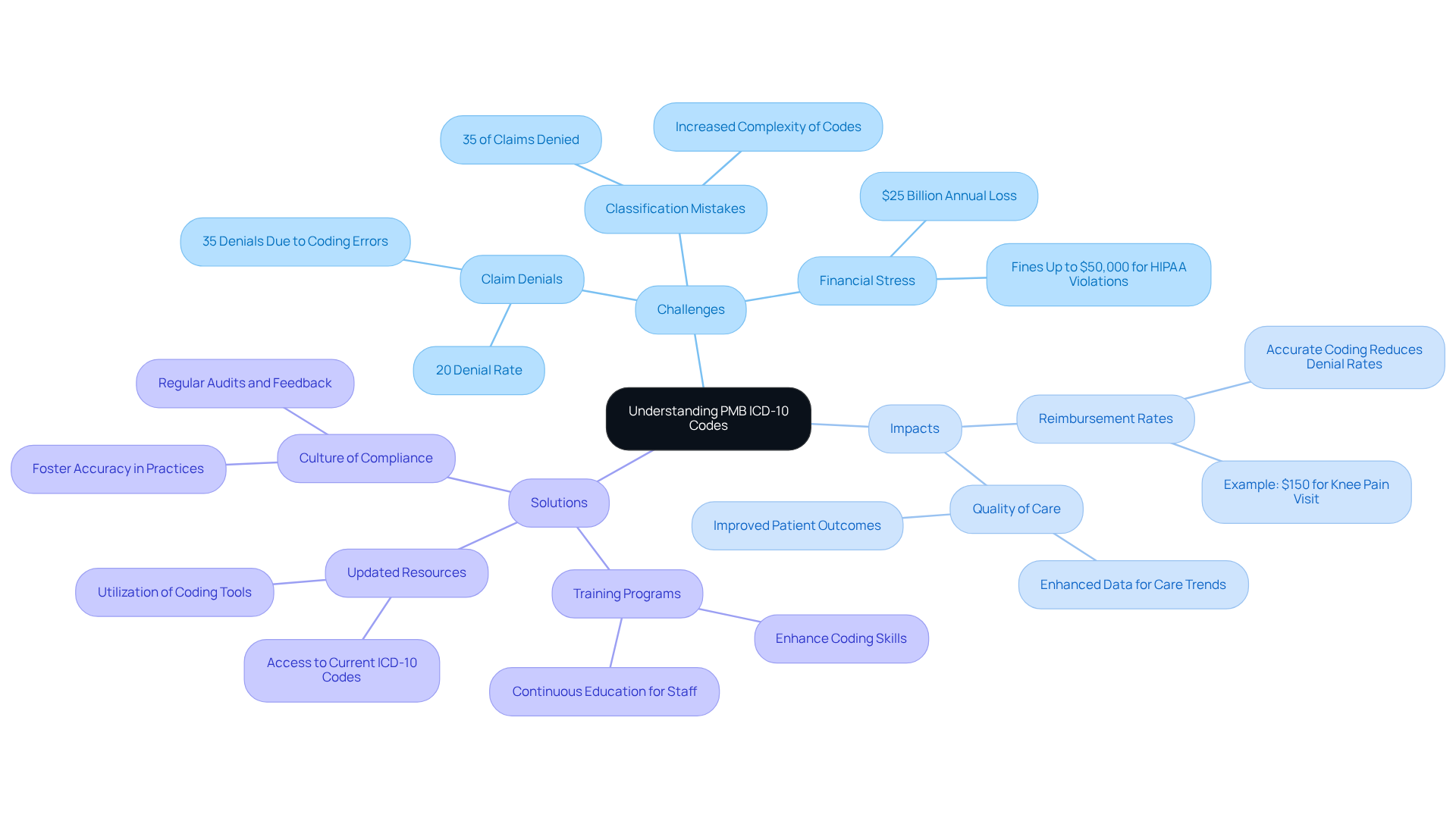
Essential PMB ICD-10 Codes: Specific Codes Every Provider Should Know
In the ever-evolving landscape of healthcare, it's crucial for providers to be well-versed in essential pmb icd 10 codes. These codes, particularly as we embrace generative AI, can significantly enhance patient care and streamline administrative efficiency.
Consider the following important codes:
- Z00.00: Encounter for general adult medical examination without abnormal findings.
- Z01.419: Encounter for other preprocedural examination, unspecified.
- F41.9: Anxiety disorder, unspecified.
- E11.9: Type 2 diabetes mellitus without complications.
- I10: Essential (primary) hypertension.
Understanding these identifiers can alleviate some of the emotional challenges healthcare providers face daily. Administrative burdens can detract from the time and energy available for patient engagement and care. By leveraging AI tools, you can simplify the documentation process related to pmb icd 10 codes, ultimately reducing administrative loads.
Imagine a work environment where you can focus more on your patients and less on paperwork. This shift not only enhances precision in invoicing but also fosters a deeper connection with those you care for. As you navigate these changes, remember that embracing technology is a step towards a more compassionate and efficient practice.
How can you incorporate these tools into your daily routine? Taking small steps can lead to significant improvements in both your workflow and patient interactions.
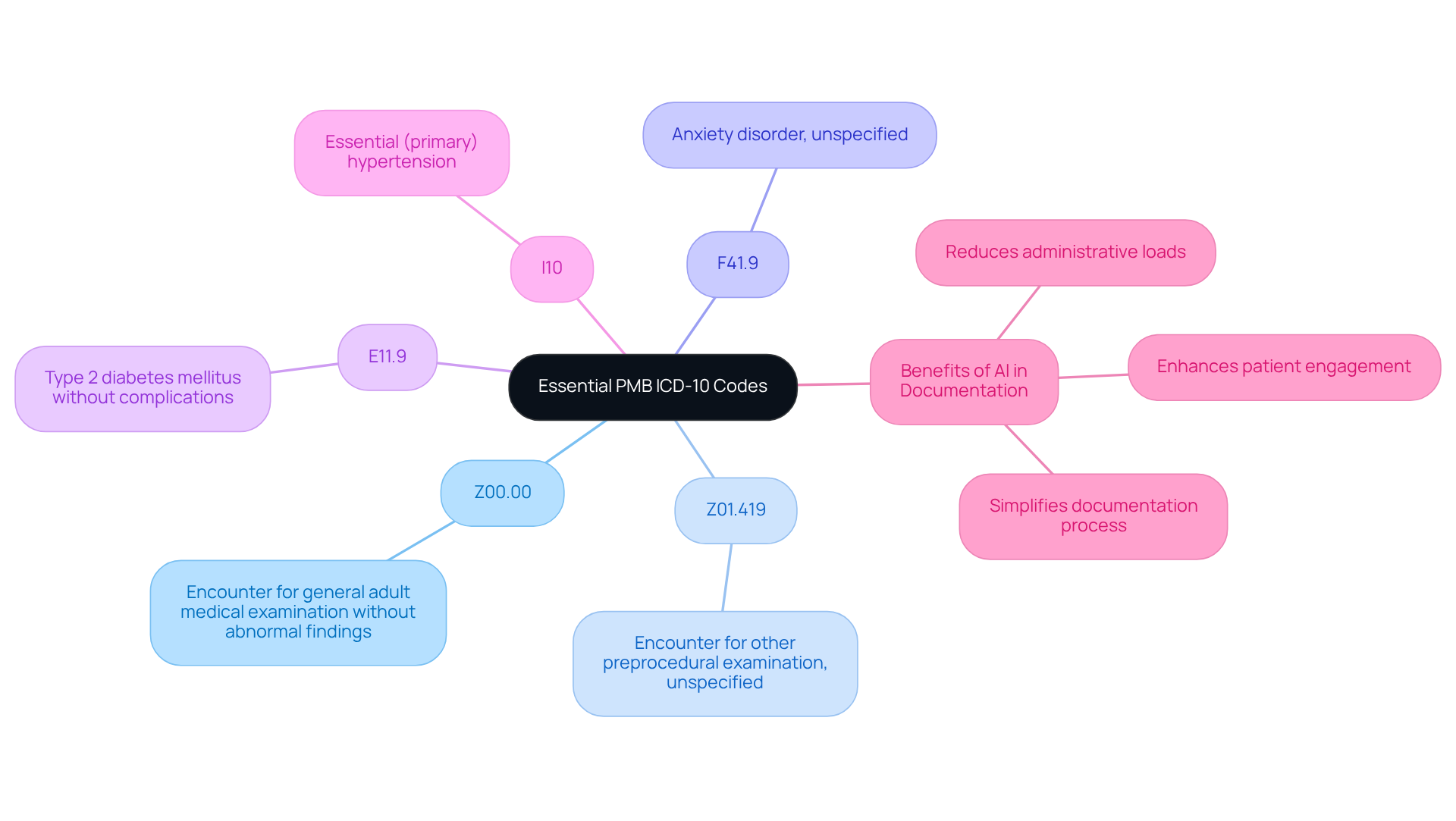
Best Practices for Medical Billing Using PMB ICD-10 Codes
To optimize medical billing using PMB ICD-10 codes, it’s essential for providers to embrace best practices that not only enhance efficiency but also alleviate some of the emotional burdens they face:
-
Stay Updated: Regularly reviewing updates to ICD-10 codes is crucial for maintaining compliance and accuracy. The transition to ICD-10 has significantly improved specificity in classification by 50%, which is vital for enhancing reimbursement precision and data quality.
-
Utilize Technology: By leveraging AI tools like CosmaNeura, providers can automate programming and invoicing processes. These AI solutions minimize human error and optimize workflows, potentially saving healthcare providers around $166 billion annually. This improvement in financial efficiency allows providers to dedicate more time to patient care rather than administrative tasks.
It’s important to ensure that all invoicing personnel are well-trained in PMB ICD-10 codes and invoicing practices. Alarmingly, 75% of trainees in finance and documentation report feeling uncomfortable with the process. Continuous education can enhance programming precision and adherence, ultimately reducing the financial strain on healthcare institutions.
-
Conduct Audits: Regular audits of invoicing practices are vital to identify and rectify errors. Research shows that 30% of insurance claims are rejected upon initial submission, often due to input mistakes. Implementing a feedback mechanism can significantly lower missed charges and improve revenue recovery, which is increasingly important in today’s financially pressured environment.
-
Engage Patients: Clear communication with patients about their diagnoses and costs fosters transparency and trust. Effective patient engagement can lead to quicker payments, as 90% of patients are willing to pay their bills in full when offered flexible payment options. This approach not only enhances cash flow but also cultivates a more ethical patient care environment.

Ensuring Compliance: PMB ICD-10 Guidelines for Healthcare Providers
Healthcare providers often face emotional challenges in navigating compliance with pmb icd 10 codes. It’s crucial to adhere to these standards, including the pmb icd 10 codes, not only to avoid penalties but also to enhance patient care. Here are some key compliance measures to consider:
-
Accurate Documentation: It’s essential to ensure that all patient interactions are documented accurately, reflecting the services provided. This not only supports compliance but also fosters trust with your patients.
-
Regular Training: Ongoing training for staff is vital. By keeping everyone informed about programming updates and compliance requirements, you create a supportive environment that prioritizes patient care.
-
Utilization of Authorized Identifiers: Applying only suitable identifiers for the services provided helps prevent deceptive billing practices. This approach protects both your practice and your patients.
-
Monitor Changes: Staying informed about modifications in programming guidelines allows you to adjust practices accordingly. This proactive approach can alleviate some of the administrative burdens you face.
By implementing these measures, you can not only ensure compliance but also enhance the quality of care you provide. Remember, you’re not alone in this journey—embracing these practices can lead to a more efficient and compassionate healthcare environment.
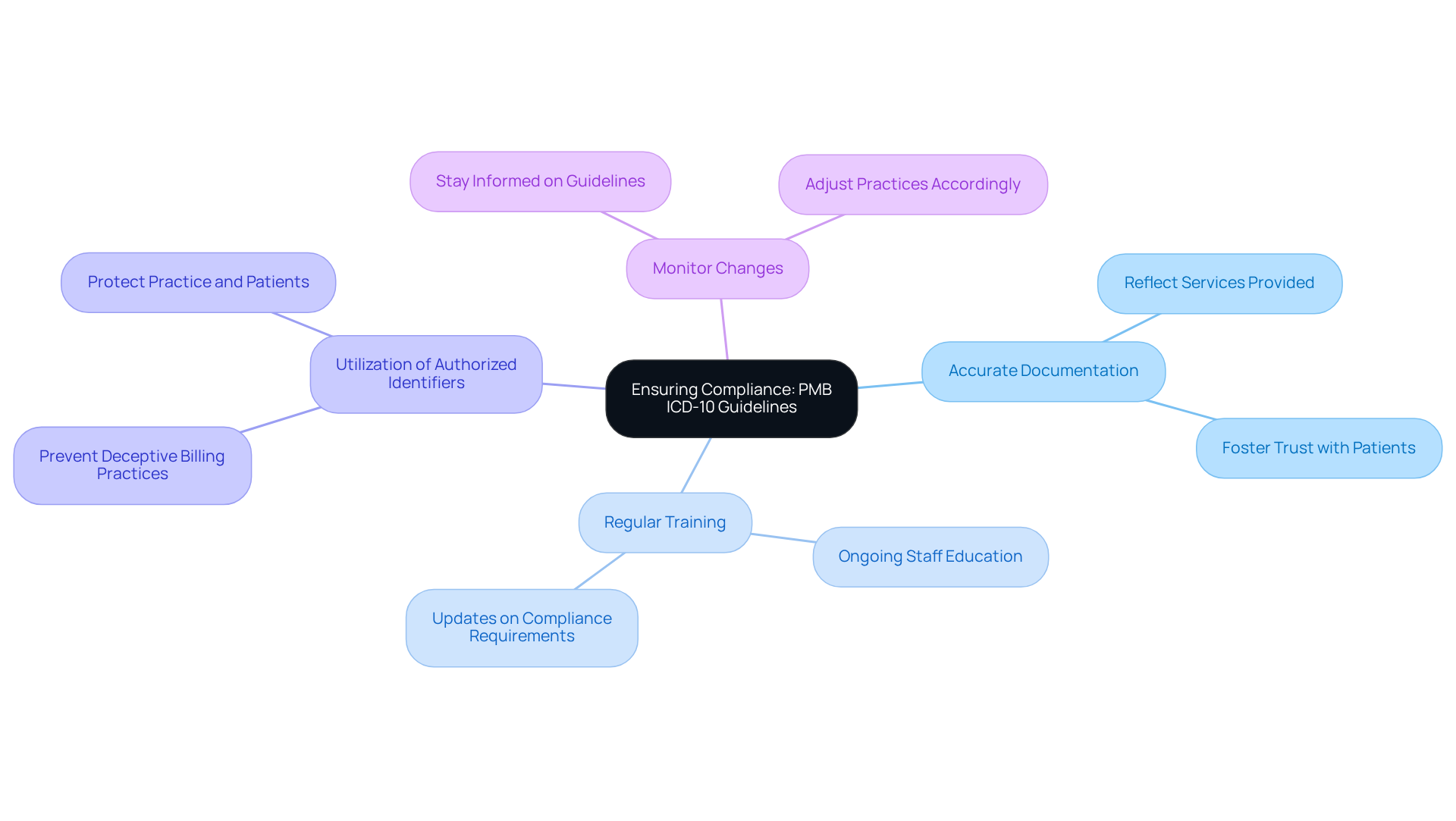
Challenges in Implementing PMB ICD-10 Codes: What Providers Need to Know
Implementing PMB ICD-10 codes presents several significant challenges for healthcare providers:
-
Complexity of Codes: With over 68,000 codes available, the extensive list can feel overwhelming. This complexity often leads to coding errors, highlighting the need for precision in selection. Providers must thoroughly understand both the patient's condition and the classification guidelines. In fact, approximately 32% of claim denials cite errors in classification as the reason for denial. This underscores the importance of precise classification practices. CosmaNeura's Agentic Platform leverages innovative AI solutions to simplify this process, enhancing accuracy and reducing the likelihood of errors.
-
Training Needs: Adequate training is crucial for staff to accurately grasp and apply ICD-10 codes. Ongoing education is essential, as healthcare organizations must keep their teams informed about the latest guidelines and changes. Statistics indicate that ongoing training enhances programming proficiency and accuracy, which is vital for minimizing errors and ensuring compliance. By incorporating generative AI into training programs, CosmaNeura can offer customized learning experiences that adapt to the evolving demands of programming, including the application of PMB ICD-10 codes.
-
Technology Integration: Incorporating ICD-10 classification into current billing systems can present technical difficulties. Organizations often face interoperability issues and coder unfamiliarity with advanced software, which can disrupt workflow. Investing in user-friendly programming software and providing robust IT support can help mitigate these challenges. The Agentic Platform's seamless integration with Electronic Health Records (EHRs) streamlines documentation processes, reducing errors and improving efficiency, ultimately enhancing patient care.
-
Resistance to Change: Opposition from staff in adopting new programming practices can hinder efficiency. Involving programmers in the training and enhancement process of AI-driven development tools can encourage acceptance and lessen hesitation towards new technologies. Transparent communication and cooperation among programming specialists, clinicians, and administrative personnel are crucial to overcoming this obstacle. As Dr. Cynthia M. McDonald pointed out, "Without precise documentation, medical providers face the risk of incorrect reimbursement, compliance challenges, and ultimately, the integrity of patient care." CosmaNeura's approach emphasizes collaboration and support, ensuring that staff feel confident in utilizing innovative solutions.
Proactively tackling these challenges with the assistance of CosmaNeura's Agentic Platform can enable a smoother implementation of PMB ICD-10 codes, ultimately enhancing accuracy and improving overall healthcare delivery.
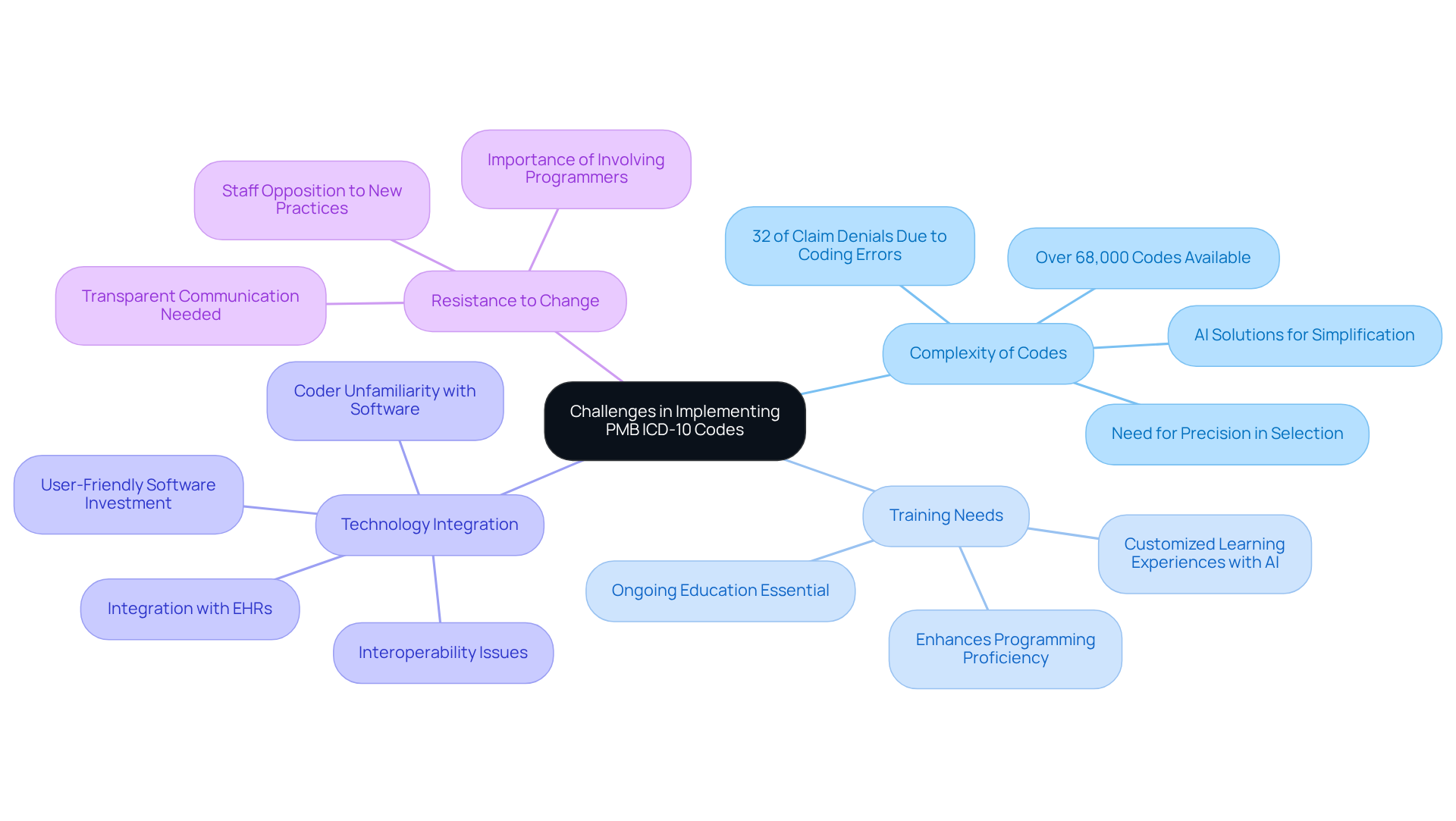
Integrating ICD-10 Codes in PMB Billing and Insurance Claims
To effectively integrate ICD-10 codes into PMB billing and insurance claims, providers should consider the following strategies:
-
Utilize CosmaNeura's AI Solutions: Implementing advanced billing software that supports ICD-10 coding is crucial. CosmaNeura's AI-driven technology simplifies the programming process and improves precision, significantly lowering the risk of claim denials. By automating programming, these solutions reduce the administrative load on healthcare providers, enabling them to focus more on patient care while addressing the rising costs of healthcare.
-
Standardize Processes: Creating uniform procedures for programming and invoicing is essential to minimize mistakes. Research indicates that practices with established workflows experience fewer documentation errors, leading to improved billing accuracy. A systematic approach ensures that all personnel are aligned and informed of programming requirements, which is vital for compliance and efficiency. Accurate documentation generates reliable medical records for patients, providing essential information for future caregivers and ultimately supporting better financial outcomes.
-
Collaborate with Insurers: Close collaboration with insurance companies is necessary to ensure that claims are submitted correctly and promptly. Consistent communication can clarify programming requirements and lessen misunderstandings that may lead to claim denials, alleviating financial pressure on medical organizations.
-
Monitor Claims: Regularly reviewing claims for accuracy is critical. Providers should follow up on any denials or discrepancies promptly. Studies show that practices implementing feedback systems can reduce missed charges by over 50%, significantly improving revenue recovery.
The impact of standardized processes on billing accuracy cannot be overstated. Precise programming reduces the risk of claim denials and aids in appropriate reimbursement for medical services. As the shift to ICD-10 has demonstrated, practices that implement detailed pmb icd 10 codes can enhance their revenue cycle management and improve overall financial stability. This approach tackles the urgent issue of rising medical expenses while ensuring compassionate patient care.

FAQs on PMB ICD-10 Codes: Answers for Healthcare Providers
Here are some frequently asked questions regarding PMB ICD-10 codes:
-
What are PMB ICD-10 codes?
PMB ICD-10 codes are standardized codes essential for documenting diagnoses and procedures in medical billing. They ensure consistency and accuracy across healthcare practices, helping to alleviate some of the administrative burdens that can distract from patient care. -
Why are these numbers significant?
These codes play a critical role in securing accurate billing and reimbursement for healthcare services. This directly impacts the financial health of medical practices and, ultimately, the quality of care provided to patients. -
How frequently do I need to update my programming knowledge?
Regular updates are crucial, especially with the annual changes to the ICD-10 coding system. For instance, in the 2025 update, 252 new codes were added, and 36 codes were deleted. Staying informed helps prevent errors that could lead to lost revenues and compliance issues, which can be a source of stress for many healthcare providers. -
Can I use obsolete numbers?
No, utilizing outdated codes can lead to claim denials and compliance challenges. It's essential for healthcare professionals to ensure they are using the most current codes to avoid these pitfalls and to maintain a smooth billing process.
Healthcare providers have reported that staying informed about updates in billing can significantly reduce claim denials. For example, Wayne Carter highlights that mistakes in programming can result in lost revenues and non-compliance with CMS regulations. Regular training and updates are essential for maintaining coding accuracy and ensuring proper reimbursement.
Additionally, implementing a best-in-class data governance solution can reduce the time spent processing updates by 90%, further enhancing efficiency and allowing healthcare providers to focus more on patient care.
By prioritizing these updates and training, you can not only safeguard your practice's financial health but also contribute to a better experience for your patients.
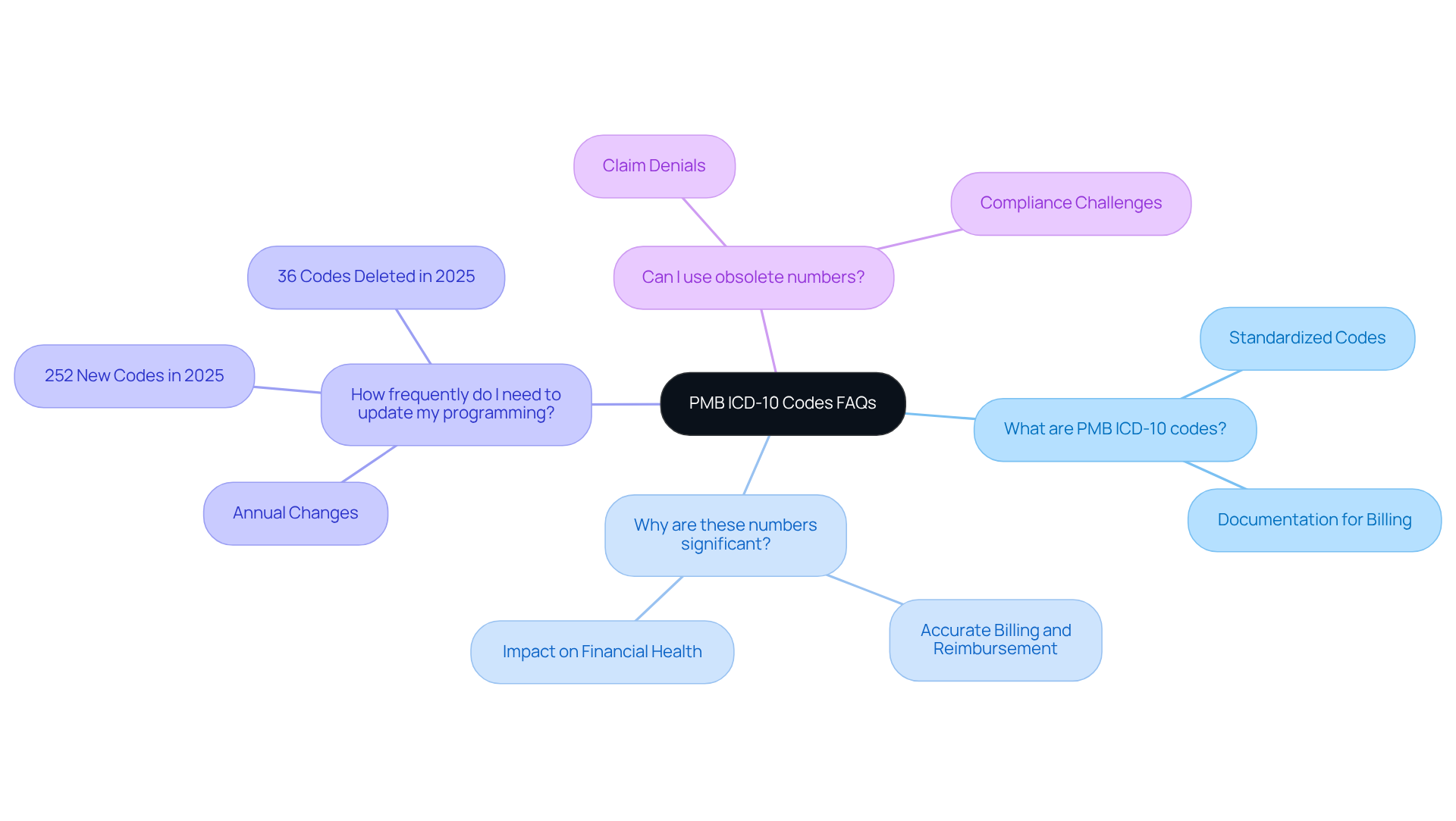
Understanding Condition Codes in PMB Medical Billing
Condition indicators are essential in PMB medical billing, offering crucial insights into a patient's situation and the circumstances surrounding their care. Understanding these codes is vital for several reasons:
-
Enhancing Claims Accuracy: Condition codes clarify the context of care, significantly reducing the likelihood of claim denials. Did you know that precise labeling can prevent over 80% of denied claims, often caused by vague or mismatched codes? In Saudi Arabia alone, yearly losses from elevated claim rejection rates are estimated at approximately 9 billion SAR, highlighting the financial burden of billing mistakes. By leveraging innovative AI solutions like CosmaNeura's Agentic Platform, medical providers can optimize classification processes, ensuring greater precision and effectiveness.
-
Improving Patient Care: Accurate condition coding not only aids in billing but also enhances patient management and outcomes. When a patient's condition is accurately reflected, providers can tailor their approaches, leading to improved health outcomes. Generative AI can analyze patient data, enabling more personalized care strategies that meet individual needs.
-
Facilitating Communication: These codes enhance communication between providers and insurers, ensuring everyone understands the patient's needs and the care provided. This transparency fosters trust and reduces disputes over charges, ultimately enhancing the patient experience.
-
Real-World Impact: Consider this: medical organizations that adopt strong condition classification practices often see a significant rise in cash flow and a reduction in administrative burdens. One health system reported a 30% decrease in claim denials after improving its classification processes, demonstrating the tangible benefits of precise condition classification. Practices that submit error-free claims consistently experience increased cash flow, allowing them to invest more in patient care and operational improvements.
-
Importance for Compliance: Adhering to condition classification standards is not just about precision; it ensures compliance with regulations, protecting providers from potential audits and penalties. As the American Medical Association states, "Adhering to coding regulations and guidelines is vital in the medical invoicing sector," underscoring the importance of compliance in maintaining financial well-being.
In summary, understanding and applying precise pmb icd 10 codes is crucial for service providers aiming to enhance claims accuracy, improve patient care, and ensure compliance in an increasingly complex invoicing environment. By integrating innovative solutions like those offered by CosmaNeura, providers can effectively address the administrative burdens that often impede optimal healthcare delivery.
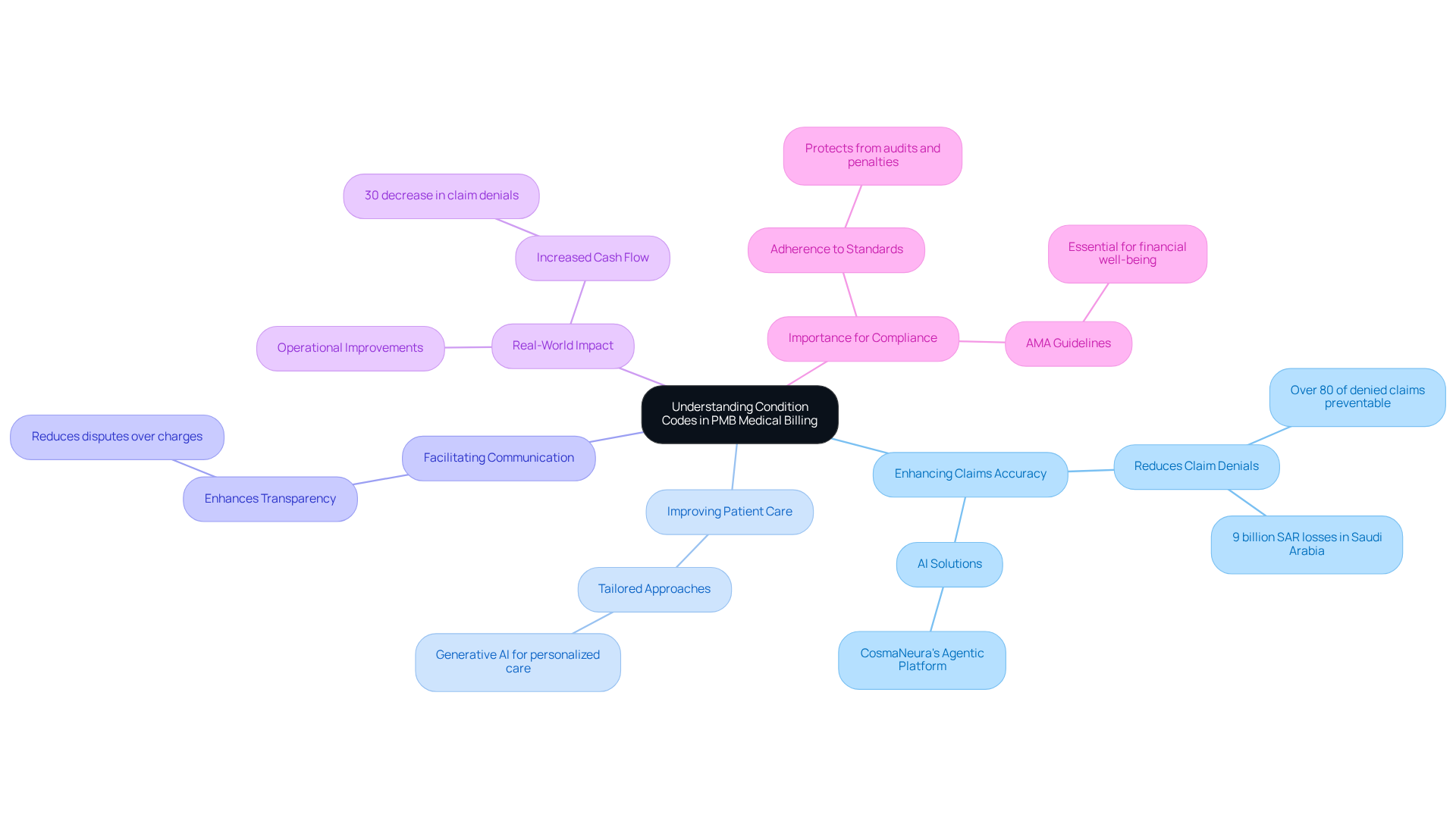
Common Medical Conditions Covered Under PMB: A Quick Reference
Here is a quick reference for common medical conditions covered under PMB:
- Hypertension: I10
- Diabetes Mellitus: E11.9
- Anxiety Disorders: F41.9
- Asthma: J45.909
- Chronic Obstructive Pulmonary Disease (COPD): J44.9
Understanding these conditions and their corresponding ICD-10 codes is crucial for optimizing billing efficiency. Have you ever felt overwhelmed by the sheer volume of administrative tasks? Accurate coding for hypertension and diabetes not only reduces claim denials but also expedites reimbursement processes, alleviating some of that burden.
Statistics reveal that healthcare providers who consistently apply accurate ICD-10 codes see a 20% rise in invoicing efficiency. This improvement can lead to enhanced cash flow and decreased administrative burdens, allowing you to focus more on what truly matters—patient care. Familiarity with PMB ICD 10 codes not only enhances billing accuracy but also ensures that patients receive timely and appropriate care.
By embracing these insights, you can make a significant difference in both your practice and your patients' experiences. How might this knowledge empower you to streamline your processes and provide even better care?
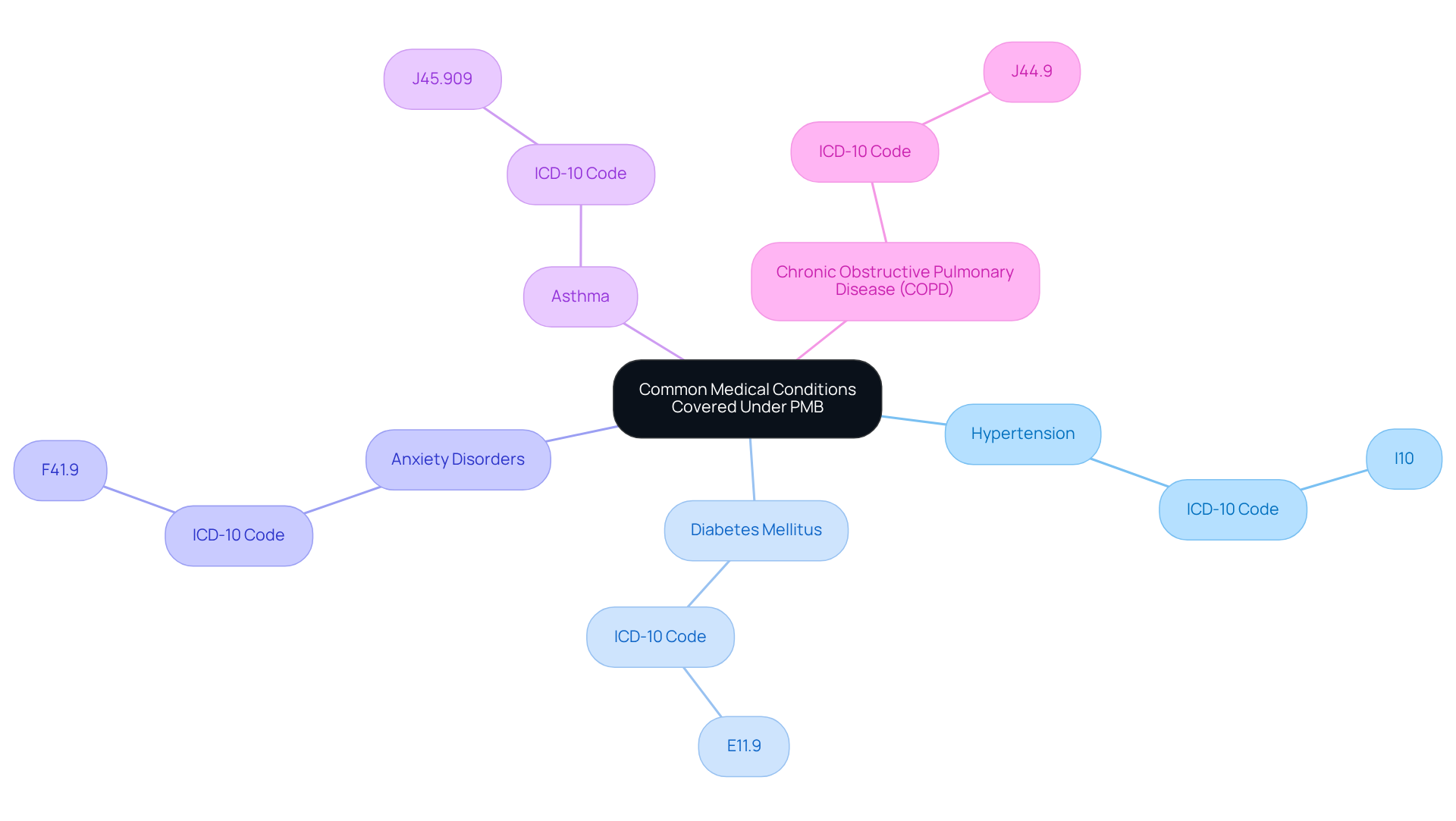
Conclusion
Embracing the intricacies of PMB ICD-10 codes is essential for healthcare providers who strive to enhance their billing practices while also improving patient care. These codes serve as a standardized language that facilitates accurate documentation and reimbursement. This ultimately alleviates financial pressures on medical practices. By mastering these classifications, providers can ensure compliance, reduce claim denials, and foster a more efficient healthcare environment.
Have you considered the emotional challenges you face in navigating these complexities? Throughout this article, we’ve highlighted several key insights, such as the importance of ongoing training, the integration of AI solutions like CosmaNeura, and the necessity of accurate documentation. With over 70,000 diagnosis codes available, understanding specific PMB ICD-10 codes can significantly impact your practice's financial health and operational efficiency. Furthermore, employing best practices such as regular audits and effective patient engagement can enhance both revenue recovery and patient trust.
The journey towards optimizing PMB billing and ensuring compliance with ICD-10 codes is not just about financial stability; it is also about delivering compassionate, high-quality care. By investing in training, leveraging technology, and committing to accuracy, healthcare providers can truly transform their practices.
The time to act is now—embrace these strategies to alleviate administrative burdens and focus on what truly matters: providing exceptional care for your patients. Remember, your dedication to understanding and implementing these codes not only supports your practice but also enhances the overall patient experience.




